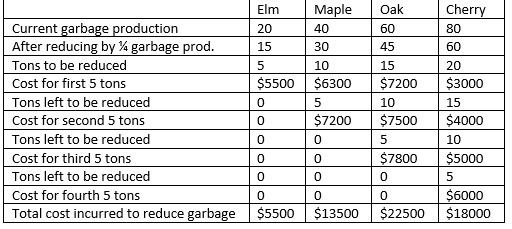a. Suppose the government mandates that each firm reduces its garbage output by a quarter. Calculate the cost of requiring each firm to reduce the weight of its garbage by one-fourth of its current garbage level.
a. Suppose the government mandates that each firm reduces its garbage output by a quarter. Calculate the cost of requiring each firm to reduce the weight of its garbage by one-fourth of its current garbage level.
Chapter1: Making Economics Decisions
Section: Chapter Questions
Problem 1QTC
Related questions
Question

Transcribed Image Text:**Problem 5: Garbage Reduction and Cost Analysis**
Four firms called Elm, Maple, Oak, and Cherry, produce wooden chairs. However, they also produce a great deal of garbage (a mixture of glue, varnish, sandpaper, and wood scraps). The first row in the following table shows the total amount of garbage (in tons) currently produced by each firm. The other rows of the table show the cost of reducing garbage produced by the first five tons, the second five tons, and so on.
| | Elm | Maple | Oak | Cherry |
|-------------------------|-----|-------|-----|--------|
| **Current production of garbage (in tons)** | 20 | 40 | 60 | 80 |
| **Cost of reducing garbage by first five tons** | $5,500 | $6,300 | $7,200 | $3,000 |
| **Cost of reducing garbage by second five tons** | $6,000 | $7,200 | $7,500 | $4,000 |
| **Cost of reducing garbage by third five tons** | $6,500 | $8,100 | $7,800 | $5,000 |
| **Cost of reducing garbage by fourth five tons** | $7,000 | $9,000 | $8,100 | $6,000 |
| **Cost of reducing garbage by fifth five tons** | $7,500 | $9,900 | $8,400 | $7,000 |
**a.** Suppose the government mandates that each firm reduces its garbage output by a quarter. Calculate the cost of requiring each firm to reduce the weight of its garbage by one-fourth of its current garbage level.
**b.** Now, imagine that marketable permits are issued (given for free) to each firm for ¾ of their current level of garbage: Elm gets ¾*20 = 15 tons worth of permits, Maple gets permits for ¾*40 = 30 tons, etc. The firms can either use the permits for their own garbage, or sell them if they produce less garbage than they have permits for, or they must buy additional permits if they produce more garbage than they have permits for. What will be the result of this alternative approach to reducing pollution? How many tons of garbage will each firm produce? What would be the overall cost of reducing garbage production by ¼? What will be
Expert Solution
Step 1: answer part (a)
When the government mandates each firm to reduce its output by a quarter the scenario is as follows:

Step by step
Solved in 2 steps with 1 images

Knowledge Booster
Learn more about
Need a deep-dive on the concept behind this application? Look no further. Learn more about this topic, economics and related others by exploring similar questions and additional content below.Recommended textbooks for you


Principles of Economics (12th Edition)
Economics
ISBN:
9780134078779
Author:
Karl E. Case, Ray C. Fair, Sharon E. Oster
Publisher:
PEARSON

Engineering Economy (17th Edition)
Economics
ISBN:
9780134870069
Author:
William G. Sullivan, Elin M. Wicks, C. Patrick Koelling
Publisher:
PEARSON


Principles of Economics (12th Edition)
Economics
ISBN:
9780134078779
Author:
Karl E. Case, Ray C. Fair, Sharon E. Oster
Publisher:
PEARSON

Engineering Economy (17th Edition)
Economics
ISBN:
9780134870069
Author:
William G. Sullivan, Elin M. Wicks, C. Patrick Koelling
Publisher:
PEARSON

Principles of Economics (MindTap Course List)
Economics
ISBN:
9781305585126
Author:
N. Gregory Mankiw
Publisher:
Cengage Learning

Managerial Economics: A Problem Solving Approach
Economics
ISBN:
9781337106665
Author:
Luke M. Froeb, Brian T. McCann, Michael R. Ward, Mike Shor
Publisher:
Cengage Learning

Managerial Economics & Business Strategy (Mcgraw-…
Economics
ISBN:
9781259290619
Author:
Michael Baye, Jeff Prince
Publisher:
McGraw-Hill Education